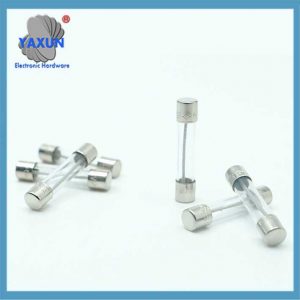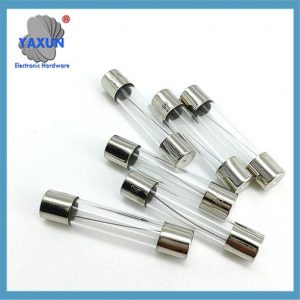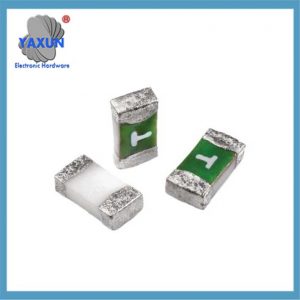빠르게 행동하는 퓨즈와 느린 퓨즈의 핵심 차이는 응답 속도와 응용 시나리오에 있습니다.: 빠른 작용 퓨즈는 민감한 구성 요소를 보호하기 위해 즉시 불고 있습니다, 느리게 나타나는 퓨즈는 서지 전류를 견딜 수 있도록 부는 지연이 지연됩니다.
주요 차이점 분석
분사특성 및 응답속도.
고속 작동 퓨즈:
응답 시간이 매우 빠릅니다., 밀리초 안에 불고 (일반적으로 0.1ms-5s) 과전류가 발생할 때. IC 칩, 반도체 장치 등 정밀 전자 부품 보호에 적합합니다.. (UL 규격).
그들은 줄 열 효과를 따릅니다. (Q = I²Rt), 단순한 퓨즈 디자인을 가지고 있습니다., 빠른 열전도를 위해 좁은 단면의 금속선을 사용합니다..
순간 전류에 민감하여 전원 켜기/끄기 또는 모터 시동 중 서지 전류를 견딜 수 없습니다..
느리게 작동하는 퓨즈:
단기 과전류를 견딜 수 있습니다. (예를 들어, 7 정격 전류를 곱한 값 0.5-3 모터 시동 중 초).
시간 지연 기능이 있습니다., 취득 5 에게 10 융합하는 데 몇 초 2 정격 전류의 시간, 단기적인 고전류 서지를 견딜 수 있습니다. (모터 시동 전류와 같은 7 정격 전류의 시간).
용융열가가 높다., 석영 모래 또는 나선형 디자인의 열 흡수를 통해 지연된 퓨즈 개방 달성.
패스트 블로우 애플리케이션:
저항 부하 회로 (전기 난방 기기, LED 조명);
민감한 반도체 장치 보호 (단락 보호를 위한 MOSFET 및 리튬 배터리 팩 등);
저항 부하 (전기 주전자, 밥솥);
리튬 배터리 팩, 회로 기판 등 민감한 회로 보호;
단락 전류의 신속한 차단이 필요한 애플리케이션.
슬로우 블로우 애플리케이션:
유도성/용량성 부하 (모터, 스위칭 전원 공급 장치);
서지 보호가 필요한 애플리케이션 (100kVA 이상의 변압기에 대한 자화 서지 보호 등);
모터와 같은 유도성/용량성 회로, 전원 공급 장치, 및 인버터;
시동 돌입 전류가 적용되는 장비 (스위칭 전원 공급 장치 및 변압기와 같은);
펄스 전류 내성이 요구되는 환경 환경.
보호 기능의 차이점 속단 퓨즈: 단락 보호만 제공하며 과부하와 과도 펄스를 구분할 수 없습니다..
슬로우 블로우 퓨즈: 과부하 및 단락 보호 기능을 모두 제공, I²t 값 사용 (전류와 시간의 제곱의 적분) 에너지를 결정하기 위해.
주요 매개변수 및 선택 요점
IT 곡선 차이
속단 퓨즈는 더 가파른 곡선을 가집니다., 정격 전류의 2배에서 녹는 시간이 0.1초 이하; 슬로우 블로우 퓨즈는 더 평평한 곡선을 가지고 있습니다., 정격 전류의 2배에서 10초 이상의 내구 시간.
교환 위험
지속 퓨즈를 속단 퓨즈로 교체하면 장치가 시작되지 않을 수 있습니다.; 속단 퓨즈를 속단 퓨즈로 교체하면 민감한 부품이 손상될 위험이 높아질 수 있습니다..
비용 및 구조
슬로우 블로우 퓨즈는 특수 합금이나 복잡한 구조로 인해 더 비쌉니다..
선택 고려 사항
매개변수 계산 우선순위:
회로 최대 서지의 I²t 값이 퓨즈의 내력 값보다 작은지 확인하십시오. (예를 들어, 전원 공급 장치는 15A/150ms 서지 테스트를 통과해야 합니다.).
차단 용량은 시스템의 최대 단락 전류보다 높아야 합니다. (예를 들어, 35kA 단락의 경우, 50kA 차단 용량을 선택하세요).
일반적인 오해:
고온으로 인해 슬로우 블로우 퓨즈의 정격 전류가 떨어질 수 있습니다. 30%.
UPS에서 속단 퓨즈를 잘못 사용하면 잘못된 트립이 발생할 수 있습니다. (한 건의 손실이 발생했습니다. 1.8 백만 위안).
실험에 따르면 리튬 배터리가 단락되면, 슬로우 블로우 퓨즈로 인한 열 폭주 확률은 속단 퓨즈보다 8배 더 높습니다..
인버터 테스트 중, 슬로우 블로우 퓨즈를 잘못 사용하면 모듈 손상률이 증가할 수 있습니다. 1% 에게 37%.
 English
English Afrikaans
Afrikaans العربية
العربية বাংলা
বাংলা bosanski jezik
bosanski jezik Български
Български Català
Català 粤语
粤语 中文(简体)
中文(简体) 中文(漢字)
中文(漢字) Hrvatski
Hrvatski Čeština
Čeština Nederlands
Nederlands Eesti keel
Eesti keel Suomi
Suomi Français
Français Deutsch
Deutsch Ελληνικά
Ελληνικά हिन्दी; हिंदी
हिन्दी; हिंदी Magyar
Magyar Bahasa Indonesia
Bahasa Indonesia Italiano
Italiano 日本語
日本語 한국어
한국어 Latviešu valoda
Latviešu valoda Lietuvių kalba
Lietuvių kalba македонски јазик
македонски јазик Bahasa Melayu
Bahasa Melayu Norsk
Norsk پارسی
پارسی Polski
Polski Português
Português Română
Română Русский
Русский Cрпски језик
Cрпски језик Slovenčina
Slovenčina Slovenščina
Slovenščina Español
Español Svenska
Svenska ภาษาไทย
ภาษาไทย Türkçe
Türkçe Українська
Українська اردو
اردو Tiếng Việt
Tiếng Việt



